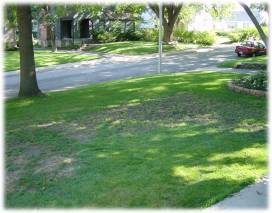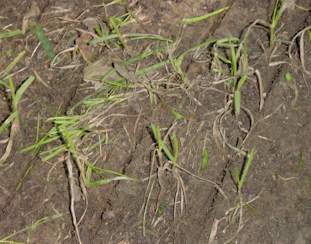|

|
In
the Kansas City area it is not uncommon for cool-season lawns to
look less than perfect after the stress of a hot summer. Disease,
drought, heat, poor soil or just plan old neglect may mean that
it's time for a round of overseeding. In fact some people
have found that in the Kansas City area cool-season grasses should
be treated almost as though they are hardy annuals or delicate
perennials. In other words, to keep a lawn looking great it will
probably need at least some overseeding each year. |

A
normally attractive lawn has suffered from disease
(lower left) and the prolonged presence of heavy
machinery (center). |
|
|
The optimum time to seed
cool-season turfgrasses in Kansas City is during September. This is
when nature establishes cool-season grasses; therefore, the best results
with the least amount of work occur at that time. Do not delay
seeding or the grass will not establish sufficiently before winter and
weeds like henbit and chickweed become a problem. March and April
are second choices for seeding but are a distant second at best.
Follow these steps
to a denser, healthier lawn each fall:
Before You Start
- Get A Soil Test
If you haven't done so in the last 3-5 years take the time to have your
lawn soil tested by your local extension office. Simply scoop up
some soil (a total of 2-3 cups is plenty) from several areas of your
lawn, place it in a bag or plastic container and bring it to your local
extension office. The soil will be analyzed and a report, including
recommendations will be mailed to you. There will be a small fee for
the service.
Careful With The
Chemicals
If you wish to completely eliminate existing vegetation (grass, weeds,
ivy, etc...) Roundup can be used. Make sure you complete your last
application at least five days prior to seeding. Also...
- Do not use
crabgrass preventers before seeding or on young grass. These are
best used as pre-emergents in the early spring anyway.
- Do not use
broadleaf weed killers one month before seeding or on new grass until
it has been mowed three times.
Choose Your Seed
Most Kansas City area homeowners will want to use Tall Fescue, Bluegrass
or a combination of both.
Kentucky
Bluegrass
With proper management, Kentucky bluegrass forms a fine-textured,
high-quality, long-lasting turf. This species produces rhizomes
(underground stems) that give rise to new bluegrass plants. This
ability enables bluegrass to rapidly recuperate from injury and fill in
thin areas in the lawn. Kentucky bluegrass is winter-hardy and
capable of withstanding temperature and moisture extremes. During
hot, dry periods it tends to become dormant and lose color. If
high quality is desired during the summer period, lawn irrigation is
often necessary. Kentucky bluegrass requires moist, well-drained
soil to develop into high-quality turfgrass. Although Kentucky
bluegrass performs best in full sun, some cultivars are adapted to
shade.
Tall Fescue
Tall fescue has been used traditionally as a low-maintenance grass
in areas where a coarser texture is not objectionable. Tall fescue
tolerates soils of low fertility, persists well under low maintenance
and possesses good tolerance to insects and diseases. When mature,
tall fescue has excellent wear tolerance and, due to its deep-rooted
nature, tolerates drought and will remain green throughout most Kansas
City summers.
Recently, a number
of improved "turf-type" tall fescue cultivars have been
commercialized. These improved tall fescues are finer textured
than the old "Kentucky-31" cultivar. These improved
cultivars are less coarse, grow more upright, tiller more readily and
exhibit a darker green color. All tall fescues grow rapidly in the
spring and require more frequent mowing than Kentucky bluegrass.
The popularity of the improved turf-type tall fescues is increasing and
they are now being used on many lawn sites, playgrounds, parks and
low-maintenance athletic fields where the use of coarser textured
grasses is not objectionable.
When in doubt your
best bet is to find a reputable local garden supply or seed
supplier. Visit them, explain your sunlight and soil
conditions. Their recommendations should be adequate.
Things to look for:
- Good
blends. Most seed is sold as a blend of two or more seed
varieties. This helps protect your lawn from succumbing to
disease.
- How well did the
seed perform in national and local turf trials? The retailer
should have this data.
- Make sure the
seed meets your lawn's sunlight requirements. Grass that thrives
in full sun may not grow well in part-shade. Shade tolerant
grasses may wilt and die in sunny areas.
- How much weed
seed is in the mix? There should be very little or no weed seed
in quality seed mixtures.
Remember that good
seed usually costs a little more. If your lawn is important to you a
couple of extra dollars will be well worth it.
Getting Started -
Prepare the Soil
Mow the area to 1½ inches to reduce competition from
established grasses. Short mowing helps prevent the seed from
lodging in tall grass and lets light reach the new seedlings. Use a
grass catcher on the mower or sweep up excess clippings. Do not
scalp off all the existing turf - some is needed to protect the
germinating seed from wind, hot sun, and heavy rain.
Core
Aerate the area, punching at least 20 to 40 holes/ft2
with the largest tines possible. This will increase the seed-soil
contact and improve germination and establishment rate. You're not
likely to over do it, so make several passes over the lawn.
Aerators can be rented from many hardware stores or the whole process
can be done by a professional lawn care company.
The use of a
verticutter or over-seeder is also recommended. This machine
(available for rent at many hardware and rental stores) cuts vertical
grooves into your soil creating a nice soil to seed contact area (see
picture below). It's best to make two or three passes over your
lawn at different angles creating a cross-hatch pattern.
 |
 |
|
Each
pass of the verticutter (above left) or over-seeder will leave shallow
trenches about 1/8 inch wide (above right). |
Putting Down
Seed
Apply the seed to the lawn with either a rotary or drop-seeder (some
verticutters also include a seed hopper to distribute seed). The
table below lists the suggested
seeding rates.
| Seed Type |
Rate per 1,000 sq. ft. |
| Kentucky Bluegrass |
2-3 pounds |
| Tall Fescue |
6-8 pounds |
Food, Water,
and Mowing
Apply a slow release nitrogen fertilizer over the lawn and water it in
completely. To ensure proper germination you will need to keep the
seeds moist. This means watering three to four times daily. Light,
frequent watering will yield the best results.
Tall fescue will
germinate in approximately 2-3 weeks. Bluegrass takes a little
longer, approximately 3-4 weeks.
Five weeks after germination, apply
a quick release nitrogen fertilizer at a rate of 1 lb/1000 ft2
. Repeat this procedure in another six weeks for a total of three
fertilizer applications (including the first at seeding time).
Mow your new
cool-season grass as soon as it is 3 inches tall with the mower set at 2
inches. Continue to mow at that height for the remainder of the
season, including the last mowing.
Relax
The root system of your new turf will continue to grow and strengthen
even after the blades have stopped growing for the season. You
will be rewarded with a quick thickening, healthy lawn next spring.
Sources:
Savvygardener.com
Kansas
State University Extension
Purdue Turfgrass Science Program
Ohio
State University Extension |




